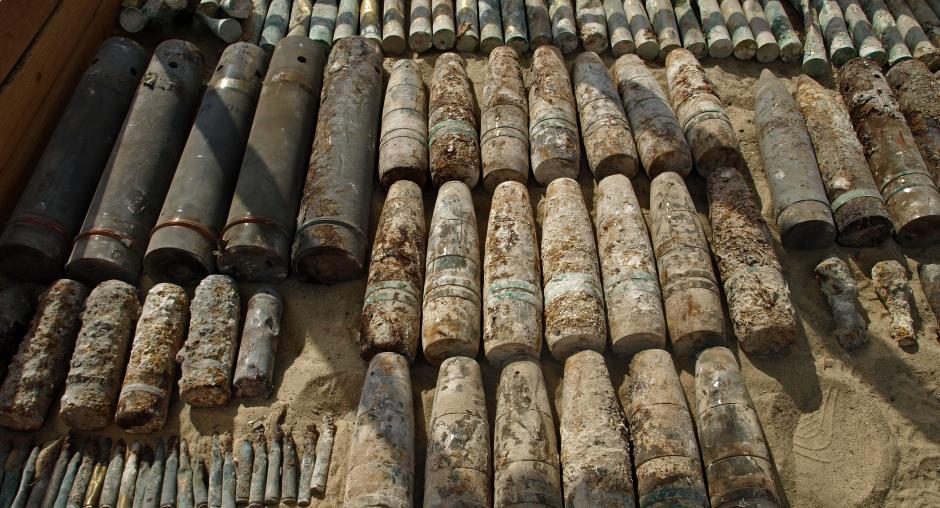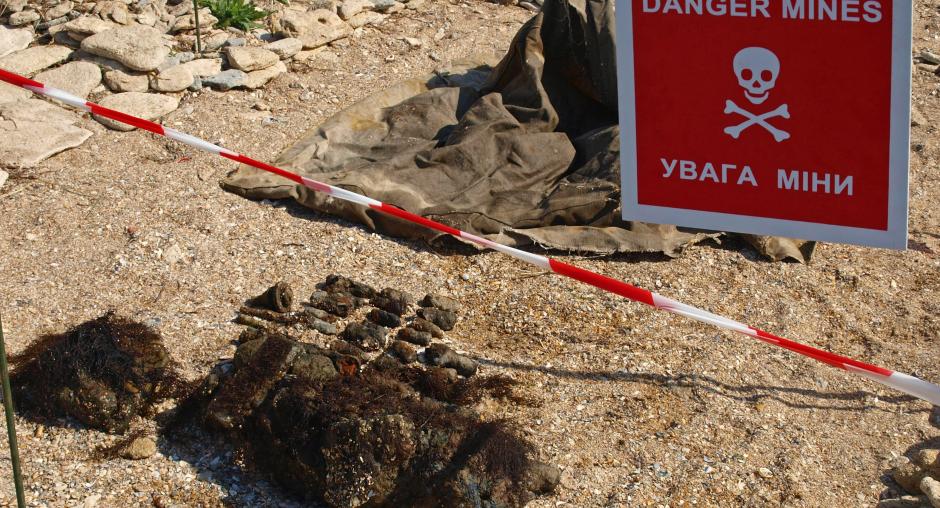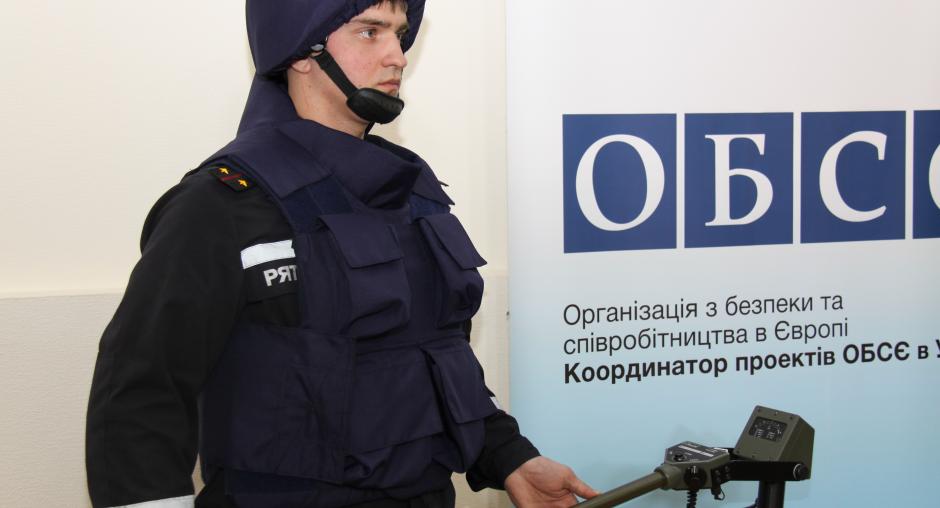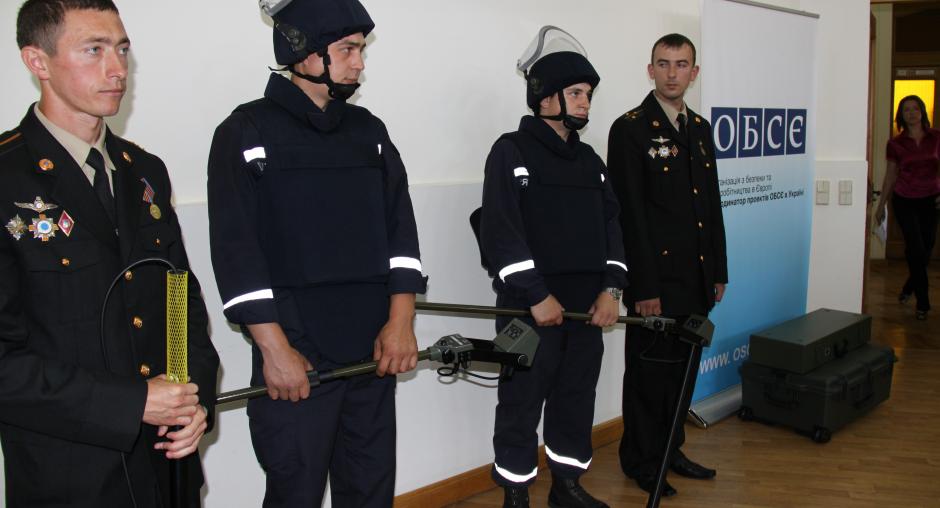Life-saving education
Ahead of the summer holidays, a high-risk period in areas with remnants of war and military exercises, the OSCE Project Co-ordinator in Ukraine (PCU) supported the State Emergency Service of Ukraine (SESU) to run awareness-raising classes on the risks and threats of unsafe military ammunition. These classes are part of multi-year efforts aiming to reduce accidents with children discovering remnants of wars and military exercises.
In early May 2014, more than 300 children in several at-risk communities aged 13 to 16 watched educational videos and presentations produced by the OSCE Project Co-ordinator, listened to lectures by explosive hazard experts and were introduced to the recently launched life safety web portal to help understand how to handle situations when explosives are encountered.
Legacies of past wars and Soviet era militarism
In the course of the 20th century, Ukraine was the scene of the fiercest battles of two World Wars and a civil war. Soviet military ambitions also contributed to the current situation, leaving independent Ukraine with massive amounts of surplus ammunition, stockpiled in various locations throughout the country. Accidents, remnants of military exercises or improper storage of those stocks are also a source of danger for people living in close proximity to storage sites.
WATCH: Ukrainian demining experts are removing discovered WWII unexploded ordnance. (Video source: State Emergency Service of Ukraine)
According to official statistics, during the first five months of 2014 over 20 thousand dangerous military items were discovered in Ukraine. In 2012-2013 deminers had to deal with almost 90 thousand explosive objects, and this figure doesn’t include the 35 thousand tonnes of bombs, shells and mines that were destroyed in Lozova, Kharkiv region, in the course of a clearance operation in the areas, affected by a 2008 accident at an ammunition storage base.
Focus on children as a vulnerable group
Due to economic hardship, many people search for and collect munitions on the sites of former military ranges, which lack adequate survey and clearance, for sale as scrap metal. Recovered explosives and fuses are also occasionally used in fish poaching. Handling these deadly materials is extremely dangerous. According to official statistics, in 2008-2013 62 people were killed and 98 were wounded in accidents involving the so-called “remnants of war”.
Potential monetary gain is not the only driving force behind the interest in the munitions. Curiosity coupled with leisure, and a lack of knowledge and understanding of the dangers involved can often drive youngsters toward an adventurous discovery of old military “treasure” that is likely to turn into a tragedy.
In summer 2009, locals from Yasna Poliana village, near Henichesk (southern Ukraine), noticed kids jumping into the water of the Sivash, an Azov Sea coastal lagoon, from suspicious looking metal items. They moved the children away and called the emergency services. Our responders arrived to discover seven moored naval mines, each weighting 1 tonne. They were originally produced in 1918, dating back to World War I. When those mines were destroyed by Emergency Service experts, the explosion produced a fountain almost 200 meters high. It’s a curiosity with a happy ending. But when we talk to kids about such things, we always stress how dangerous playing with potentially explosive items can be.
Vasyl Merzeniuk, Head of a special response unit of Ukraine’s Emergency Service in Kherson region
Official records confirm the urgency of the problem – 11 children killed and 25 sustained injuries from old munitions in the past 5 years. Nevertheless there are some positive developments, as the sad figures are on the decline. One of the reasons behind the declining numbers can be attributed to systemic efforts by the country’s Emergency Service to educate juniors on do’s and don’ts in cases when they find anything that looks like a military item. In 2012-2014 the OSCE Project Co-ordinator in Ukraine actively supported this initiative, notably the production of an animated clip and a documentary for children, the design and printing of information posters distributed to Ukrainian schools, and the recently-launched life safety web portal for children.
The OSCE also supported the production of a cartoon and documentary in 2012 to support awareness raising in Ukrainian schools:
Cartoon instructing children on DO's and DON'Ts if explosive ordnance is found (in Ukrainian):
Broadcast-quality video for television channels can be downloaded here.
To access the files please use Username: d1FF and Password: VniC
Campaign to minimise threats from explosive remnants of war for civilians (in Ukrainian):
Broadcast-quality video for television channels can be downloaded here.
To access the files please use Username: Ryyx and Password: XH1h
Warning children of threats posed by unsafe ammunition: a 25-minute documentary (in Ukrainian):
The Emergency Service experts go to schools to conduct life safety lessons and to increase outreach among the youth. These meetings are popular with the children. Since watching war movies may inspire curiosity and even desire to take a closer look at anything that could be “military” the Emergency Service experts strive to use that interest to explain what the consequences may be.
The OSCE Project Co-ordinator team has joined these classes for a second year in a row in advance of the holidays to deliver lectures, show films and distribute awareness-raising materials focusing on communities that are at particular risk.
Kherson region in southern Ukraine is washed by two seas and bears numerous scars of World War II. The Azov Sea shore near Henichesk witnessed several cases of encounters by children with moored naval mines. The Kalanchak district, adjacent to the Black Sea, was in the thick of battles for the Crimean peninsula in the 1940s. In 2010, 620 mortar bombs were recovered near one of the local railway stations. On average 300-400 unexploded or abandoned ordnance items are found in the district each year. So, for schoolchildren in Henichesk and Kalanchak districts, messages of risk education are more than relevant. Here, the experts also encouraged pupils to share their knowledge with local adults, juniors and thousands of summer holidaymakers from all over Ukraine, who come to visit the area every year.
Kirovograd region (central Ukraine). Until the 1990s, the Kompaniivka range was used for air bombing exercises. Unexploded aerial bombs of up to 100 kg weight are a threat to locals, with 2 lives claimed by the explosion of one of them in the last decade. This also hampers agricultural development in the area, as clearance operations in the former range were suspended due to funding constraints. So for OSCE and State Emergency Experts, the task was to make sure that pupils of local schools are well aware of the potential to encounter unsafe ammunition, as well as of what to do in such cases.
Awareness-raising is not the only instrument used by the OSCE to help the Ukrainian government deal with the problem. Over the past few years the OSCE Project Co-ordinator also provided assistance to upgrade the technical capacity of the State Emergency Service of Ukraine. More information about the OSCE Project Co-ordinator’s efforts to enhance protection of Ukrainians from threats related to explosive hazards can be found on the OSCE Project Co-ordinator's Arms Control activity page.
















